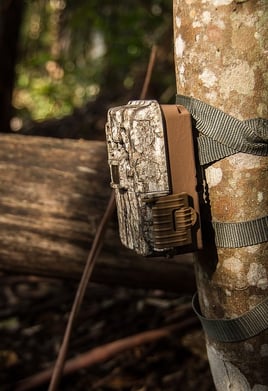Wildlife Resources Management students at Hocking College have been using a unique method of studying animals in their natural habitat. Instead of actually capturing the animals, the students are employing trail cams for more natural and less obtrusive photos.
This year, while reviewing the films for their wildlide capstone program, Hocking College students were in for a big surprise when they captured a bobcat on trail cam.
What is a Trail Cam?

Trail cams are rugged and weatherproof cameras designed for extended and unmanned use outdoors.
Moreover, they can be strategically placed in various areas most likely to be frequented by the indigenous species. Since the trail cams are automatically triggered by movement, they can capture animals without “spooking” them. The result can often be dramatic and surprising.
Remote trail cameras have been used in the wildlife profession for around 50 years now, and as the technology continues to improve and become more affordable, this method continues to become more common than traditional trapping of wild animals.
Capturing the Bobcat on Trail Cam
Students in the wildlife capstone course conduct a 15-week study using two cameras per group, during which they determine the placement of their cameras, are responsible for checking them weekly, and present their findings to the class in the final week of the semester.
A variety of species are usually documented, such as deer, turkey, coyote, rabbit, opossum, raccoon, and squirrel. There is always hope that something a little more unusual will grace their cameras, like foxes, skunks, owls, or bobcats. We are still waiting to catch our largest mammal in Ohio on the cameras, the elusive and state endangered black bear!
Recently, however, one group of students were surprised to find an excellent and clear image of a bobcat casually sauntering across a wooded area at night.
 While bobcat sightings are not necessarily rare in southeastern Ohio, their shy nature makes it difficult to see one that is not reacting to some sort of unnatural stimuli. The students’ trail cam revealed a bobcat who was caught unaware rather than one fleeing from humans trudging noisily through the woods.
While bobcat sightings are not necessarily rare in southeastern Ohio, their shy nature makes it difficult to see one that is not reacting to some sort of unnatural stimuli. The students’ trail cam revealed a bobcat who was caught unaware rather than one fleeing from humans trudging noisily through the woods.
WRM Program gives students unlimited opportunities
Students who graduate from the Wildlife Resources Management program leave prepared to work in the wildlife profession doing a variety of things. Many students continue their education to become a Wildlife biologist or game warden; others go directly to work in careers such as wildlife technician, wildlife officer, environmental educator, zoo employee, park naturalist, or state or federal employee. The versatility of this degree makes it appealing to anyone that enjoys working outdoors and with animals.
Interested in a Wildlife Resources Management program? Apply today!
The wildlife capstone trail camera project exemplifies our philosophy here at Hocking of a hands on, experience-based education that is unique from any other program in the country. The program's reputation for teaching in a non-traditional "classroom" setting provides opportunities for success for many students that do not thrive in that traditional classroom, and we couldn't be prouder of that!



.png?width=653&height=280&name=Hocking%20CTA%20-%20Awareness%20(1).png)